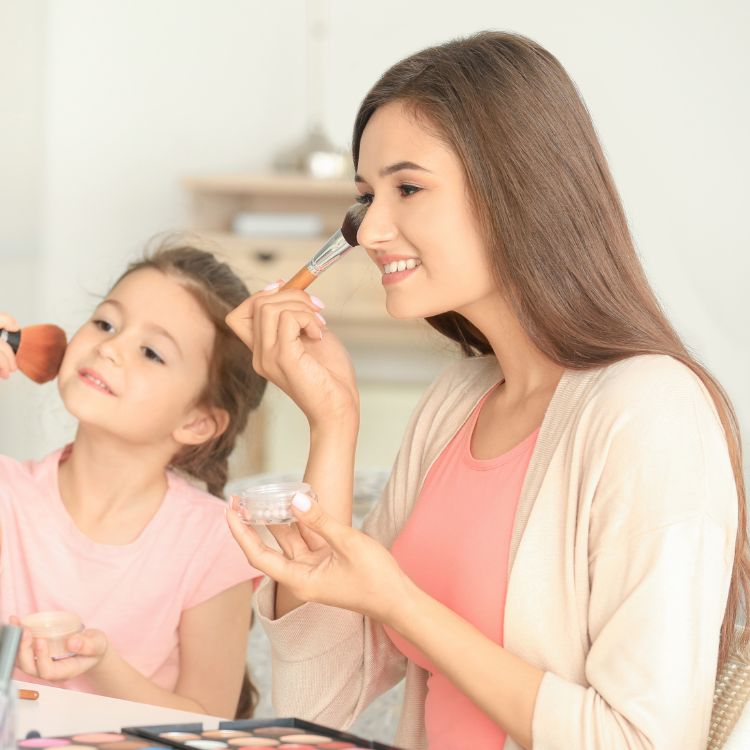As a parent, you want to make sure that your child is safe and healthy in every way possible. Not every child will wear makeup but, for those that do, have you ever considered what’s in the makeup products that they use? Some people might say that kids shouldn’t be wearing makeup at all. Personally, I think I was around the age of 16 when I started to wear makeup. These days, I see kids much younger than that wearing makeup. In some cases, it relates to artistic performances, for example, dancing competitions, eisteddfords and the like. I know many young children involved in these activities will often wear makeup for special performances. Other kids just want to have fun playing with makeup like the grown-ups do.
When young kids do wear makeup, in many cases, they will simply wear their mother’s makeup, or older sibling's makeup, which can be a real concern, especially if that makeup is of the traditional kind that's filled with potentially harmful ingredients – chemicals that can be absorbed though the skin. If mum or big sister has made the switch to natural makeup, then it’s not so much of a concern.
The dangers of toxic makeup for kids
So, what are the dangers of toxic makeup for kids? Traditional makeup products – for both adults and kids – often contain harmful chemicals such as lead, phthalates and formaldehyde. These chemicals can be absorbed through the skin and have been linked to various health problems such as cancer, hormone disruption and developmental delays. It's super important to choose non-toxic kids' makeup to protect your child's health and well-being. You don’t want them to be using products on their skin that can potentially interfere with their normal developmental stages.

Non-toxic kids' makeup is the better choice when kids wear makeup (image source: Canva)
Understanding the ingredients to avoid in kids' makeup
When choosing non-toxic kids' makeup, it's important to understand which ingredients to avoid. Unfortunately, the list of potentially harmful ingredients to be found in makeup – including kids' makeup – is quite long. Here are some common ingredients to look out for:
- parabens, e.g. Ethylparaben, Methylparaben, Propylparaben and Isopropylparaben – associated with hormone (endocrine) disruption and biochemical or cellular level changes; also associated with skin irritation and allergies
- lead – a heavy metal, toxic to human health
- synthetic fragrances – may include phthalates (hormone/endocrine) disruptors and carcinogens; also associated with skin irritation and allergies
- formaldehyde – associated with non-reproductive organ system toxicity and irritation
- talc – associated with non-reproductive organ system toxicity and contamination concerns for asbestos-like fibres
- mineral oil, e.g. liquid paraffin, petroleum white mineral oil, liquid petrolatum – associated with non-reproductive organ system toxicity
These are just a few ingredients to be aware of – there are many more. In general, you should look for products that are free from these harmful ingredients and instead contain natural and organic ingredients that are safer for your child's delicate skin.
Benefits of non-toxic makeup for kids
Non-toxic makeup for kids is becoming increasingly popular as parents become more aware of the potential health risks associated with traditional makeup products.
Non-toxic makeup is made from natural and organic ingredients that are a safer choice for children's delicate skin. Non-toxic kids' makeup is free from harmful chemicals and synthetic fragrances that can cause skin irritation, allergies and other health concerns.
Beware of ‘greenwashing’ – a practice where brands make claims about their products being ‘natural’ or ‘organic’ but closer inspection of the actual ingredients does not back up the claims. Sure, some products may include natural ingredients or even one or two organic ingredients but it's what they don’t also exclude that is the problem – they don’t leave out the harmful ingredients that we know are not desirable in products created for use by kids (or anyone for that matter). After all, it’s just as important to know what's not in a product as it is to know what is in it – one or two good ingredients does not negate five or six bad ingredients.
Learn to check labels and, if you find ingredients you don’t recognise or understand, look them up on Google and do your own research via reputable websites.
Ultimately, if you choose non-toxic makeup for your child, you can ensure that they look and feel their best when wearing it without compromising their health.
If you're not sure where to start, we suggest you take a look at No Nasties – an Australian brand dedicated to producing natural makeup for kids, including face makeup and non-toxic peelable nail polish.

